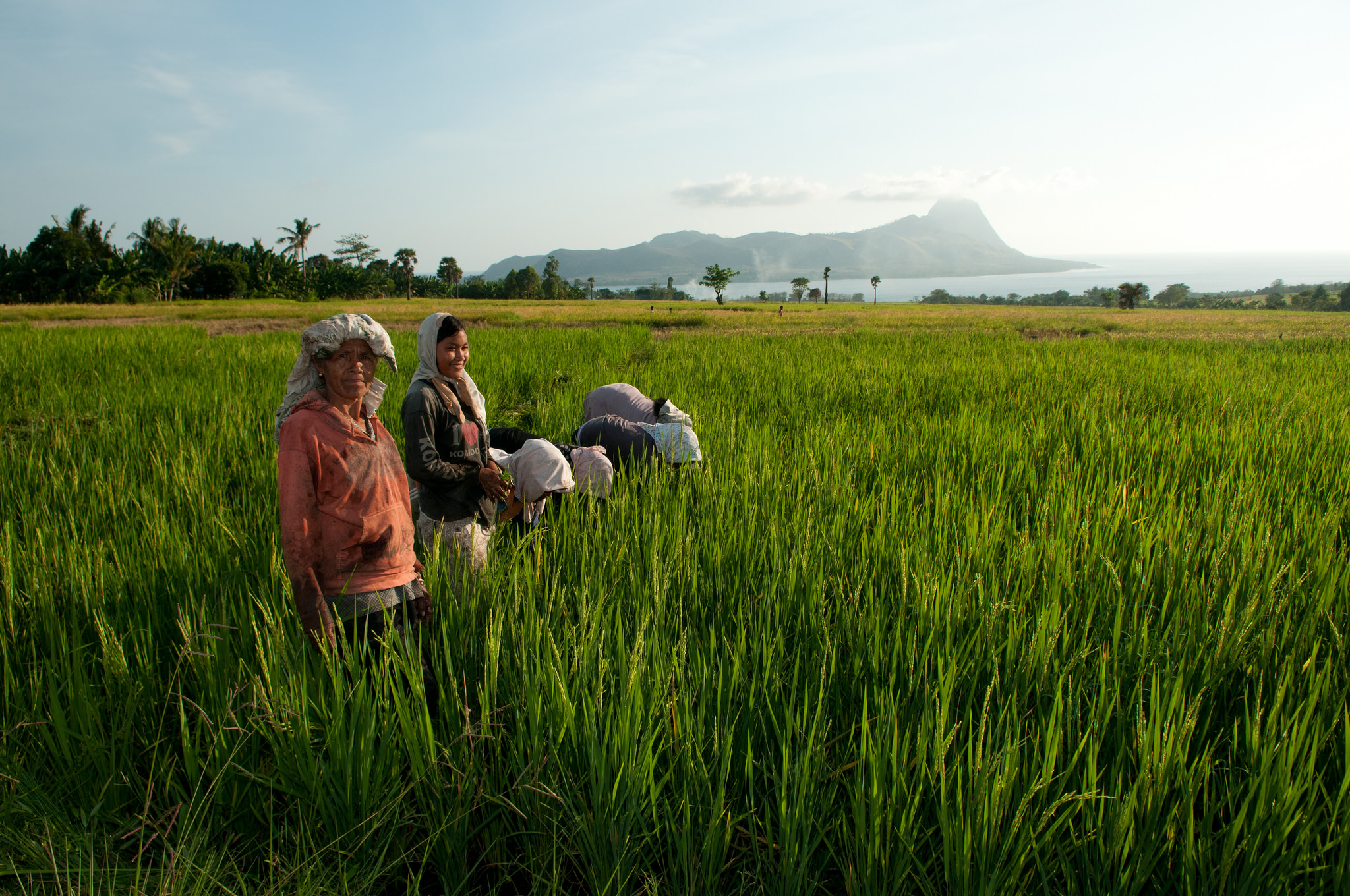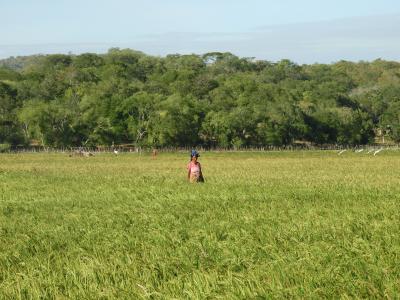
Eastern Nusa Tenggara Province is one of the poorest provinces in Indonesia with a poverty rate that stands 25.7 per cent higher than the national average (16 per cent). Agriculture production is its main source of income.
The Strategic Planning and Action to Strengthen Climate Resilience of Communities in Nusa Tenggara Timor province, or SPARC, project (2013-2018) applied a holistic approach to improving rural livelihoods and food security by strengthening climate resilience. It worked simultaneously at the policy and grassroots levels with continuous dialogue between the levels and stakeholders to ensure that policies are based on needs and lessons learned from the ground up.
Among the project's achievements:
- Enhanced institutional capacity to integrate climate resilience in sustainable development at the subnational level;
- Linkage of provincial and district governments' key policies, programmes and budget allocations with priority climate adaptation actions; and
- Strengthened rural communities in the face of a changing climate
- Community
- Local Governments
Villages in Nusa Tenggara Timor province
- NTT Development Planning Agency (BAPPEDA),Indonesia
- United Nations Development Programme (UNDP)
- Global Environment Facility (GEF)
Development in the Nusa Tenggara Timor province (NTT) has been stagnating for quite some time. It is one of the poorest provinces in Indonesia, with a poverty incidence of 25.7% as compared to 16% nationally. In particular, in the western part of Timor Island, where livelihoods are overwhelmingly dependent on agriculture (80%), erratic climate and extreme events regularly cause crop failure, placing many at risk of food insecurity. The vulnerability of the areas to exogenous and long-term change is underlined in low to extremely low income levels and food insecurity. A UN funded survey showed that the proportion of households that spent more than 75% of their income on food was quite high at 45% while more than 80% of the households spent more than 50% or of their income on food.
Scientific evidence has shown that NTT is already facing significant changes in rainfall patterns with the following trends: rainfall has become more erratic and unpredictable, resulting in greater uncertainties about when to plant and harvest; while peak rainfall in the rainy season has become more extreme, exposing NTT to higher flood risks. NTT has also been found to be one of the provinces most strongly affected by the occurrence of extreme climate events due to ENSO, leading to a deepening of the existing food security and malnutrition crisis. as compared to 16% nationally. In particular, in the western part of Timor Island, where livelihoods are overwhelmingly dependent on agriculture (80%), erratic climate and extreme events regularly cause crop failure, placing many at risk of food insecurity. The vulnerability of the areas to exogenous and long-term change is underlined in low to extremely low income levels and food insecurity. A UN funded survey showed that the proportion of households that spent more than 75% of their income on food was quite high at 45% while more than 80% of the households spent more than 50% or of their income on food.
Long term development trends indicate that human development is stagnating across the Province, and this correlates with the observed increased incidence and severity of extreme climatic events. Data from NTT clearly indicate that climate risks and impacts have also led to changing gender roles by undermining the food security of households and leading to dwindling asset bases, especially those controlled by women such as seed, cloth and small livestock. These assets are often sold during times of food shortages. However, the higher frequency of extreme climate events in NTT has meant that households are unable to recover their asset base, thus leading to further marginalization of women.
Furthermore, population growth and poor environmental management are accelerating environmental degradation and have aggravated impacts. This in turn has led to productivity decline and increased poverty, reducing resilience to climate risks. This has had a significant humanitarian impact which is undermining the ability of the provincial government of NTT to meet its Millennium Development Goals (MDGs).
The government of NTT has become aware of the linkages between climate change and the worsening trends in food security, and acknowledges the need for a more holistic and bottom-up approach for rural development. Recently, it has shown strong commitment to address these issues, and aims to integrate them in the implementation of the medium-term development plan 2009-2013. The latter is of great importance as that would allow for the adjustment of provincial and local government policies, programs, resource allocations, and initiate community based actions to strengthen climate resilience. Within this context the Province needs to develop the knowledge, tools, skills base and systems to progressively increase the resilience of vulnerable rural communities to climate risks through a mix of policy reforms, planning measures, capacity development and the introduction of new adaptation technologies and livelihood options.
The project will apply a holistic approach to improve rural livelihoods and food security by strengthening climate resilience. It will work simultaneously at the policy and grassroots levels. It will create continuous dialogue between these levels and stakeholders involved to ensure that policies to be developed or revised are based on needs and lessons learned from the grassroots.
Through the mechanism of pilot and demonstration work in communities across three target districts, together with systematic dissemination of lessons and experiences, new climate resilient approaches will be extended to a much larger rural constituency across NTT. These approaches will first be identified and analyzed in a participatory manner then crafted around existing livelihood systems and coping strategies. The proposed training programme for government, NGO/CSO and academia will be based on these pilots and demonstrations which will also function as field schools.
Project Objective: Enable the NTT province to strengthen climate Resilience of rural Communities in Nusa Tenggara Timor province
Outcome 1: Increased understanding and capacity to plan for climate induced threats and risk reduction responses affecting vulnerable areas and communities in NTT.
- Output 1.1 Provincial platform for multi-stakeholder dialogue, coordination and awareness raising established, with links to community, local, national and regional networks for dissemination of knowledge and best practice.
- Output 1.2 A training programme on climate change adaptation developed and institutionalized in the province and 300 persons from government agencies, universities and CSOs trained.
- Output 1.3 Provincial and district systems in place for the analysis and monitoring of climate change risks, vulnerabilities and impacts
Outcome 2: Local government and rural communities have integrated climate resilience actions in their development policies, plans and programmes
- Output 2.1 Provincial government has identified key-policies and programmes at risk, possible adaptation measures and necessary budgetary allocations.
- Output 2.2 District governments (3 districts) have identified key programmes at risk, priority adaptation measures and made necessary budgetary allocations for managing such risks.
- Output 2.3 At least 60 villages have integrated adaptation measures in their community vision maps (Law 32/2004) under implementation.
Outcome 3: Livelihoods and sources of income diversified and strengthened for vulnerable rural communities in 3 districts
- Output 3.1 In at least 60 villages, rural livelihood practices and systems, that have been developed and tested on social, economic and environmental terms, are adjusted to more variable and extreme climatic conditions.
- Output 3.2 In at least 30 villages, critical water harvesting and storage facilities have been rehabilitated taking into account projected changes in rainfall patterns.
- Output 3.3 In at least 60 villages diversified and ‘off-farm’ livelihood options less sensitive to climate have been developed and tested as assessed for economic feasibility.
- Output 3.4 An effective climate risk knowledge management system covering three districts has been established
- UNDPAngus MackayRegional Technical Advisor
- UNDPVerania AndriaCO Focal Point

